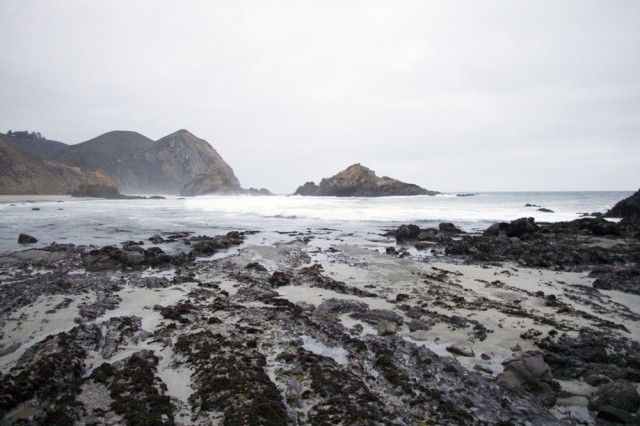Cold water: a seaweed gathering adventure
(on wild places, how to gather kelp, and things to do with it)
When I was growing up in Scotland, our summer holidays were spent on the west coast, staying in little cottages and bed and breakfasts that were out of the way, with plenty of things to explore. The edges of things and places, where wind meets earth and water, have always called to me like a siren’s song, pulled out a deep longing from inside me that expands and grows and bursts outside its bounds until I am so big I just become the world around me: sea crashing on shore, wind whipping up sea spray, shore simultaneously holding strong and giving over time. Needless to say, I’m lucky that I married someone who feels the same draw to stormy and cold seas, so every time we head north for anything, we find a way to get to the coast.
We’d been in San Francisco, hawking my wares at the Renegade Craft Fair. Early on Monday morning, we packed up the car, made ourselves coffees and packed a bag of cheese and apples and headed, from my brother’s house, across to Half Moon Bay, then down highway 1. I spent the drive thinking about how, if I didn’t know that the world was round and that there were other places out there, I’d assume that I was at the end of the world, at the edge of nothing, gazing out over the raging Pacific that even on a calm day feels untamed and enormous. The marine fog rolled in thick around us, as we drove through cypress groves with Spanish moss hanging down over the road and in the fog with the sea smells there were moments where time got lost. I love these moments. I live for these moments. Giant moments where you’re swallowed by the elements. These are good things.
We got into Big Sur around lunch time, took a nap, then went to the beach for low tide. As Jam and I walked along the shore we discussed what it is about places where the elements meet dramatically that draws humans to them, almost unconsciously. It calls to something primal in us, and the stronger the elements are in these places the more we feel it, and the more it connects to something deep and old and outside ourselves. I think that, despite the every day dramas that keep us feeling like the centre of the world, its a huge relief to be in big places and realise that we are, in fact, not. It was cold and cloudy, the beach was empty save a couple of dog-walkers. We went at low tide because I wanted to gather bullwhip kelp while we were there, and low tide is the best time to do that.
Bullwhip kelp grows in the Northern Pacific. I’ve seen it grow as far south as Big Sur, and have yet to see it beyond that, though I rarely visit the beaches south of Big Sur so I’m not exactly an authority on the matter. It is a nutritional powerhouse— high in iodine, potassium, selenium, magnesium (the minerals that most of us are deficient in). It, like all seaweed, protects your thyroid against radiation (the iodine in seaweed binds to the same places that radioactive iodine binds to, and eating seaweed and getting regular iodine means that the radioactive iodine has nowhere to bind to) and most importantly in my book, its absolutely delicious. Some seaweeds (*cough* bladderwrack *cough*) taste so awful that its difficult to eat them, but bullwhip kelp is so tasty that its just plain snack-able.
Jam was wearing his [awesome] kilt so I sent him into the water to retrieve some broken-off kelp tops. I think the ideal way to gather bullwhip kelp is to take a kayak out to the kelp beds and gently snip off individual fronds as you paddle around, leaving the rest of the plant intact. But we didn’t have a kayak, and at low tide you’ll see it floating around in the shallow water, as fronds will break off: Bullwhip kelp is attached to the sea floor with a ‘holdfast’ (ie. a kelp root) and from this holdfast the ‘whip’ part of it reaches (up to a hundred feet!) to the surface. There’s a bulb at the top, and attached to that bulb are the kelp fronds, which fan out across the surface of the sea. You’ll find forests of these, extending up to the surface together in an eerie and beautiful underwater dance. All kelp beds are like that, mind you, eerie and beautiful, gardens hovering underwater ebbing and flowing with the tides. The whip part is vulnerable, being long and thin, and so when that breaks, the kelp drifts and inevitably ends up washed ashore. So if you don’t have access to a kayak or don’t fancy getting out into the stormy seas when its cold enough as it is, get thee to a low tide spot and watch, and wait, then wade out to retrieve it.
As far as identification goes, look for that long tubular firm whip, with a ball at the end, then fronds of kelp attached to the ball (I’m really good at this botanical identification language, eh?). As with everything, be sure before ingesting it, but if you look up pictures of bullwhip kelp and it looks identical to what you have in front of you, you don’t need to worry about poisonous lookalikes because there are none.
Processing it after that is easy— you separate the kelp fronds from the bulb, then hang the fronds to dry and do something fun with the bulb like picklingit. There’s no need to rinse them in fresh water, just rinse them off in the sea water so that there’s no sand on them. Then get them somewhere to hang to dry. I put string up in my office and kitchen, and use the clothes line, and then use wire hangers for the rest. Hang your kelp up to dry like you would anything on a washing line, somewhere dry, preferably with air flow, and then just wait. It is so high in minerals that its going to be slightly moist if there’s moisture in the air, so for the last bit you might want to put them in a dehydrator or even a low temperature oven. Its dry here in LA so I just leave them until crispy then put them in a jar when fully dry.
seaweedgathering1
sea10
sea15
As for what to do with it after you’ve dried it? I keep some (the prettiest fronds) dried in a jar for snacking on. I’ll then put some fronds in a jar near my spices, to add to bone broths and soups, and then the rest I use to make Nettle Seed and Seaweed Saltto sell in my shop (I posted a similar recipe HERE).
There are traditions of using seaweed for food and medicine in every sea-edging country. You can use them for baths (though it’d be a waste of some delicious food, in my opinion) or to make a slimy skin treat; you can grind it up to sprinkle on things, or munch on them whole; you can cover them in spices and dehydrate them to make chips, or you can rehydrate them in broths or even make seaweed salad. The possibilities are endless— if you’re near a cold water place, I highly recommend you get out and find some, then experiment.
sea16
What about you? Do you gather your own seaweed? What do you do with it?










